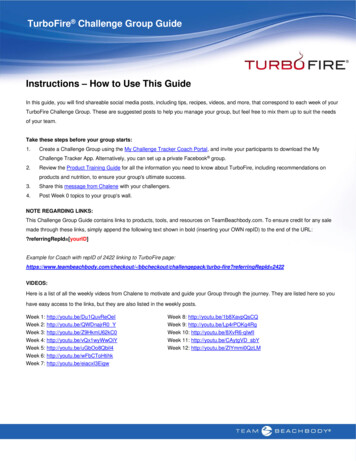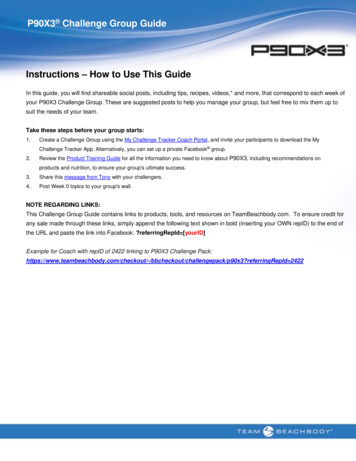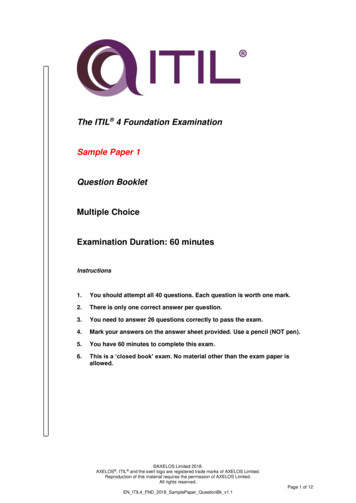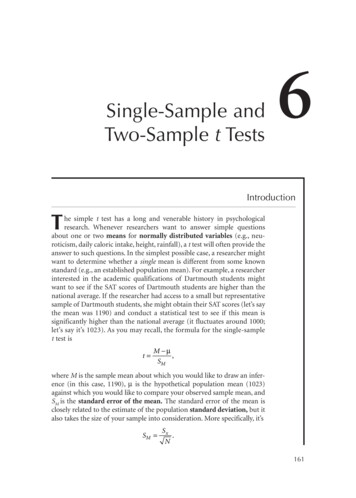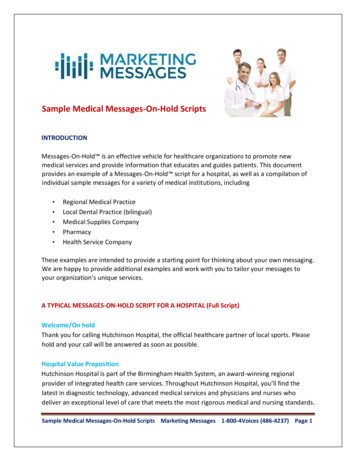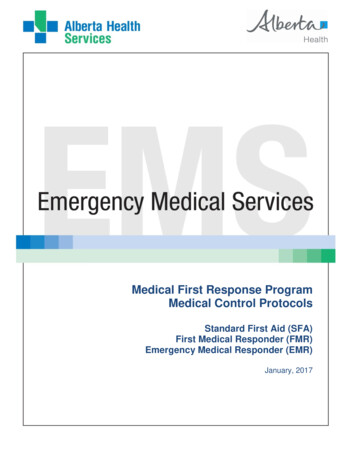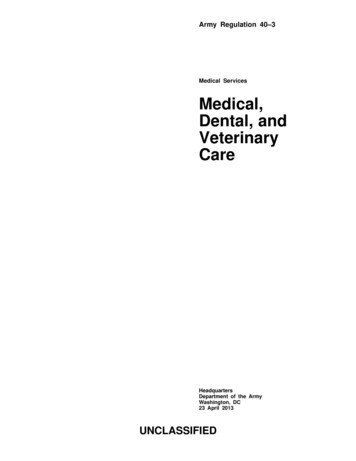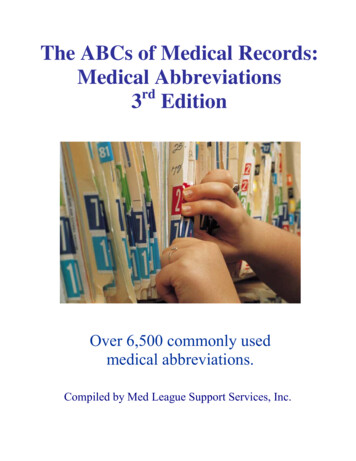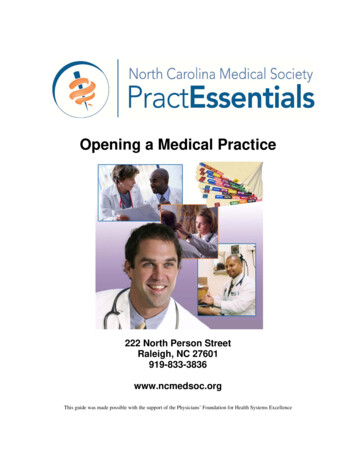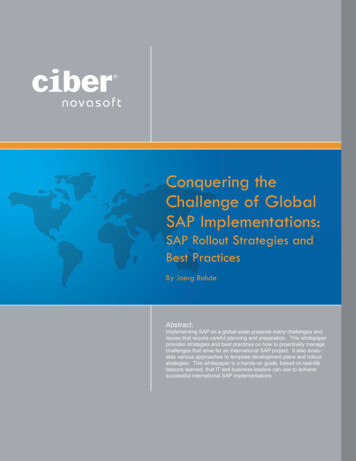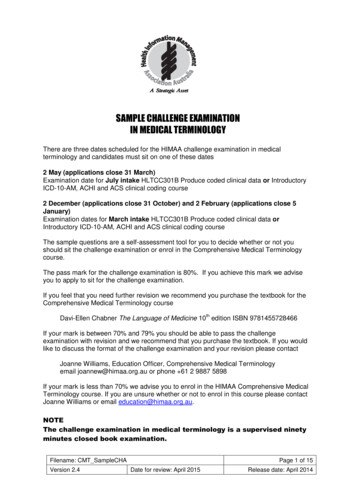
Transcription
SAMPLE CHALLENGE EXAMINATIONIN MEDICAL TERMINOLOGYThere are three dates scheduled for the HIMAA challenge examination in medicalterminology and candidates must sit on one of these dates2 May (applications close 31 March)Examination date for July intake HLTCC301B Produce coded clinical data or IntroductoryICD-10-AM, ACHI and ACS clinical coding course2 December (applications close 31 October) and 2 February (applications close 5January)Examination dates for March intake HLTCC301B Produce coded clinical data orIntroductory ICD-10-AM, ACHI and ACS clinical coding courseThe sample questions are a self-assessment tool for you to decide whether or not youshould sit the challenge examination or enrol in the Comprehensive Medical Terminologycourse.The pass mark for the challenge examination is 80%. If you achieve this mark we adviseyou to apply to sit for the challenge examination.If you feel that you need further revision we recommend you purchase the textbook for theComprehensive Medical Terminology courseDavi-Ellen Chabner The Language of Medicine 10th edition ISBN 9781455728466If your mark is between 70% and 79% you should be able to pass the challengeexamination with revision and we recommend that you purchase the textbook. If you wouldlike to discuss the format of the challenge examination and your revision please contactJoanne Williams, Education Officer, Comprehensive Medical Terminologyemail joannew@himaa.org.au or phone 61 2 9887 5898If your mark is less than 70% we advise you to enrol in the HIMAA Comprehensive MedicalTerminology course. If you are unsure whether or not to enrol in this course please contactJoanne Williams or email education@himaa.org.au.NOTEThe challenge examination in medical terminology is a supervised ninetyminutes closed book examination.Filename: CMT SampleCHAVersion 2.4Page 1 of 15Date for review: April 2015Release date: April 2014
Challenge Examination in Medical TerminologyCONTENTAll questions must be attempted. It is better to answer a portion of a question and get onequarter of a mark than to leave a blankQuestion 1 (10 marks)Answer TRUE or FALSE to the following(In the examination there are ten statements worth one mark each)(a) Both combining forms ren/o and nephr/o mean kidney(b) An acoustic neuroma is a benign tumour arising from the acoustic nerve(c) Hypothyroidism is an oversecretion of thyroid hormone(d) Pulmonary edema is swelling and fluid in the air sacs of the lung andbronchioles(e) Nephrolysis is another term for renal calculus(f) Atrial fibrillation involves rapid irregular atrial impulses and ineffective atrialcontractions(g) Secondary infertility in a female is infertility as the result of another condition(h) A condition of excessive thirst is polydipsia(i)Trigonitis is inflammation of the trigger finger(j)Hydroureter is the overdistention of the ureter with semenFilename: CMT SampleCHAVersion 2.4Page 2 of 15Date for review: April 2015Release date: April 2014
Challenge Examination in Medical TerminologyQuestion 2 (10 marks)Select from the following terms to complete the sentences below:(In the examination there are ten sentences and fifteen or sixteen terms. Each sentence isworth one otopyorrhoeaanencephaly(a)Unexpected side effects that result from treatment by a physician are described as(b)is the absence of the crystalline lens of the eye(c)An disease is a disease of unknown causation(d)is the congenital condition where the infant has no brain(e)is the surgical puncture of the abdomen for withdrawalof fluid(f)A condition of overabundance of tears is(g)A drug that reduces vomiting is an(h)Flow of pus from the ear is(i)is performed by injecting contrast material intothe uterus and uterine tubes and x-rays taken(j)A congenital anomaly known as is the absence of onekidneyFilename: CMT SampleCHAVersion 2.4Page 3 of 15Date for review: April 2015Release date: April 2014
Challenge Examination in Medical TerminologyQuestion 3 (10 marks)Indicate the most appropriate answer by circling the accompanying letter(in the examination, there are ten statements worth one mark each)(i)The meaning of the prefix auto- is(a)(b)(c)(d)(ii)Bartholin’s glands are located(a)(b)(c)(d)(iii)displaced kidneymissing kidneymulticystic kidneypolycystic kidneyDecubitus ulcer atraemiahypoglycaemiaDysplasia of the kidneys is(a)(b)(c)(d)(v)at the base of the brainat the vaginal orificein the cul-de-sacin the graafian folliclesDeficient sodium in the blood is(a)(b)(c)(d)(iv)automaticoneselfwithoutcutaneous inflammatory condition producing red, papular and vesicularlesions, crusts and scalesinflammation of the skininflammation of the skin and subcutaneous tissuea bed sore or pressure soreMajor depressive disorder (previously called endogenous depression) is(a)(b)(c)(d)depression which comes about as a result of external changes e.g. loss ofloved onedepression mainly resulting from internal biochemical causes, with episodesof severe dysphoriaanxiety that appears to be without a specific causedepression in enclosed situationsFilename: CMT SampleCHAVersion 2.4Page 4 of 15Date for review: April 2015Release date: April 2014
Challenge Examination in Medical Terminology(vii) Glaucoma is(a)(b)(c)(d)degeneration of the macula lutea of the retinaabnormal deviation of the eyeglucose in the eyeincreased intraocular pressure results in damage to the retina and optic nerve(viii) Reading, writing and learning disorder is(a)(b)(c)(d)(ix)Awareness of a pounding or racing heart alpitationmurmursinus rhythmvasospasmThe kneecap is known as the(a)(b)(c)(d)femurpatellatibiafibulaQuestion 4 (32 marks)Divide the following terms into their components (ie prefix, suffix and word root/combiningform) and give the meaning of each component. One mark is given for the correct definitionof each component part.For example neural neur (nerve) al (pertaining to)(In the examination there will be approximately twelve terms and each component is worthone mark. HINT - the number of lines next to each word is the number of components)(a) intraocular(b) encephalomyelitis(c) toxaemiaFilename: CMT SampleCHAVersion 2.4Page 5 of 15Date for review: April 2015Release date: April 2014
Challenge Examination in Medical Terminology(d) polyneuritis(e) haematuria(f) pancytopenia(g) otalgia(h) dacryoadenectomy(i) antepartum(j) sialadenitis(k) melanoma(l) colpoperineorrhaphy(m) glossodyniaFilename: CMT SampleCHAVersion 2.4Page 6 of 15Date for review: April 2015Release date: April 2014
Challenge Examination in Medical TerminologyQuestion 5(8 marks)Define the following medical termsNote information such as symptoms and aetiology should be included to illustrate youranswer but the depth of detail should be balanced against the value of a correct answer (i.e.one mark is the maximum which can be gained for each definition)(In the examination there are eight terms worth one mark each)(a) pleurisy(b) late-onset dementia(c) Parkinson’s disease(d) episiotomy(e) giardiasiscarpal tunnel syndromeFilename: CMT SampleCHAVersion 2.4Page 7 of 15Date for review: April 2015Release date: April 2014
Challenge Examination in Medical Terminology(f) osteomyelitis(g) thalassaemiaQuestion 6 (20 marks)Expand the following underlined abbreviations and write the full words they represent in thespaces provided:(In the examination a number of abbreviations may be used in a single sentence. There aretwenty abbreviations and each abbreviation is worth one mark)On examination the JVP was significantly elevated, leading to suspicion of SVC obstructionA relatively new technique involving study of the CSF may allow early noninvasive dx ofencephalitis due to HSVThis 35 year old man was admitted to the Urology Ward. Results of the MSU showed aUTI. He was given Augmentin forte t.d.s.The patient’s ECG confirmed the diagnosis of AMI. He was admitted to the ICU forstabilization of his conditionThis 51-year-old woman, with a PH of PMB, was admitted for THBSOThis 18 year old male was the passenger in a MVA. He underwent ORIF for a # L femurand his fractured R NOH was treated conservativelyFilename: CMT SampleCHAVersion 2.4Page 8 of 15Date for review: April 2015Release date: April 2014
Challenge Examination in Medical BTHBSOMVAORIF#LRNOHFilename: CMT SampleCHAVersion 2.4Page 9 of 15Date for review: April 2015Release date: April 2014
Challenge Examination in Medical TerminologyQuestion 7 (10 marks)Define the meaning of the following terms Your definition should demonstrate the differencebetween them.For examplehypertension - high blood pressurehypotension - low blood pressure(In the examination there are five pairs of terms. Each term is worth one mark. HINT - onlygive sufficient detail to define the term and demonstrate to differences - three or four wordsmay suffice for some terms) urologistnephrologist ectropionentropionFilename: CMT SampleCHAVersion 2.4Page 10 of 15Date for review: April 2015Release date: April 2014
Challenge Examination in Medical Terminology osteoarthritisrheumatoid arthritis diabetes mellitusdiabetes insipidus iliumileumFilename: CMT SampleCHAVersion 2.4Page 11 of 15Date for review: April 2015Release date: April 2014
Challenge Examination in Medical TerminologyANSWERS TO SAMPLE EXAMINATIONQuestion UE(h)TRUE(i)FALSE(j)FALSEQuestion on lename: CMT SampleCHAVersion 2.4Page 12 of 15Date for review: April 2015Release date: April 2014
Challenge Examination in Medical Terminology(x)bQuestion 4(a)intra withinocular eye(b)encephalo brainmyel spinal cord(c)tox poisonaemia blood(d)poly manyneur nerve(e)haemat blooduria urine(f)pan allcyto cell(g)ot earalgia pain(h)dacryo tearaden gland(i)ante beforepartum birth(j)sial salivaaden gland(k)melan blackoma tumour(l)colpo vaginaperineo perineum(m)glosso tonguedynia painitis inflammationitis inflammationpenia deficiencyectomy excisionitis inflammationrrhaphy sutureQuestion 5The following are examples of the way these questions could be answered, including briefdefinition, symptoms, aetiology and treatment. Quarter and half marks are given forimportant points up to a maximum of one mark per answer. Information given in brackets isnot necessary for a full mark but gives optional or alternate information.(a) pleurisyis inflammation of the pleura. It may be caused by infection, injury or tumour, or may be acomplication of lung diseases, particularly of pneumonia. Symptoms include cough, fever,chills, and a sharp pain that is worse on inspiration. Treatment is usually directed at thecause of the inflammation.(b) late-onset dementiais a general loss of intellectual abilities involving impairment of judgement, memory andabstract thinking, as well as changes in personality, usually occurring in people over the ageof 65. There is a gradual and subtle onset, with a progressive course leading to an inabilityto care for oneself.(c) Parkinson’s disease is a degeneration of nerves in the brain. Usually occurs in laterlife. Results in tremors, especially of the hands, weakness and stiffness of muscles, ashuffling gait and slowness of movement. Caused by deficiency of dopamine made by cellsin the midbrain. No known cure at present.(d) episiotomyis an incision into the perineum to enlarge the vaginal opening and to prevent it tearingduring childbirth.Filename: CMT SampleCHAVersion 2.4Page 13 of 15Date for review: April 2015Release date: April 2014
Challenge Examination in Medical Terminology(e) giardiasisis an infectious disease caused by the intestinal parasite Giardia intestinalis (formerly knownas Giardia lamblia) that produces a wide range of symptoms such as gastrointestinaldiscomfort, diarrhoea, steatorrhoea and malabsorption(f) carpal tunnel syndromeis compression (by a wrist ligament) of the median nerve as it passes between the ligamentand the bones and tendons of the wrist (carpal tunnel)(g) osteomyelitisis inflammation of the bone and bone marrow. Aetiology is bacterial infection. Bacteriaenters body through wound or comes from a skin or throat infection. Usually occurs in longbones of the legs and arms. Begins as an abscess. Treated with antibiotics.(h) thalassaemiais (group of conditions in which there is) an inherited defect in the ability to producehaemoglobin. Varying forms and degrees of severity. (The name is from the Greek thalassmeaning sea as the defect was originally named for people in the Mediterranean area withthe defect).Question 6jugular venous pressuresuperior vena cavacerebrospinal fluiddiagnosisherpes simplex virusmid stream urine (or microurine or mid specimen urine)urinary tract infectionthree times a day (ter die sumendum)it is not necessary to know the Latin meaningelectrocardiogramacute myocardial infarctionIntensive Care Unitpast historypostmenopausal bleedingtotal hysterectomy bilateral salpingo-oophorectomymotor vehicle accidentopen reduction and internal fixationfractureleftrightneck of humerusFilename: CMT SampleCHAVersion 2.4Page 14 of 15Date for review: April 2015Release date: April 2014
Challenge Examination in Medical TerminologyQuestion 7urologistspecialist in the branch of medicine which deals with the urinarysystem in females, and genitourinary system in males - a surgeonnephrologistspecialist in the branch of medicine which deals with the kidneys a physicianectropionoutward turning of the eyelidentropioninward
Filename: CMT_SampleCHA Page 4 of 15 Version 2.4 Date for review: April 2015 Release date: April 2014 Question 3 (10 marks) Indicate the most appropriate answer by circling the accompanying letter (in the examination, there are ten statements worth one mark each) (i) The meaning of the prefix auto- is (a) automatic (b) one (c) self
